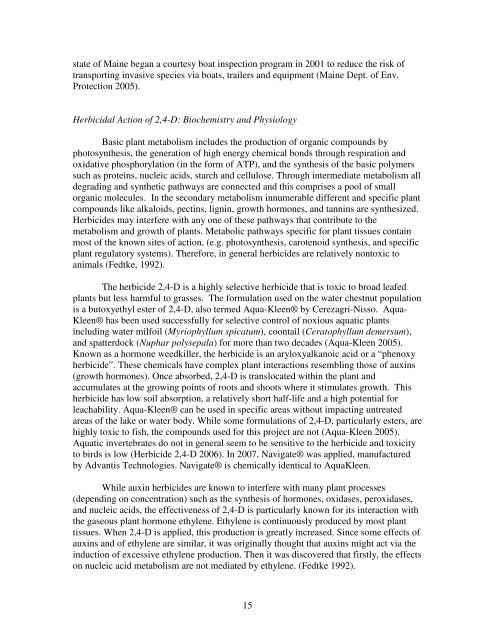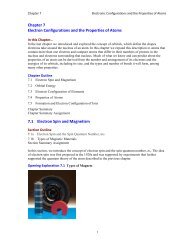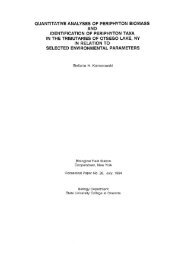Water Chestnut (Trapa natans L.) Infestation in the ... - SUNY Oneonta
Water Chestnut (Trapa natans L.) Infestation in the ... - SUNY Oneonta
Water Chestnut (Trapa natans L.) Infestation in the ... - SUNY Oneonta
You also want an ePaper? Increase the reach of your titles
YUMPU automatically turns print PDFs into web optimized ePapers that Google loves.
state of Ma<strong>in</strong>e began a courtesy boat <strong>in</strong>spection program <strong>in</strong> 2001 to reduce <strong>the</strong> risk of<br />
transport<strong>in</strong>g <strong>in</strong>vasive species via boats, trailers and equipment (Ma<strong>in</strong>e Dept. of Env.<br />
Protection 2005).<br />
Herbicidal Action of 2,4-D: Biochemistry and Physiology<br />
Basic plant metabolism <strong>in</strong>cludes <strong>the</strong> production of organic compounds by<br />
photosyn<strong>the</strong>sis, <strong>the</strong> generation of high energy chemical bonds through respiration and<br />
oxidative phosphorylation (<strong>in</strong> <strong>the</strong> form of ATP), and <strong>the</strong> syn<strong>the</strong>sis of <strong>the</strong> basic polymers<br />
such as prote<strong>in</strong>s, nucleic acids, starch and cellulose. Through <strong>in</strong>termediate metabolism all<br />
degrad<strong>in</strong>g and syn<strong>the</strong>tic pathways are connected and this comprises a pool of small<br />
organic molecules. In <strong>the</strong> secondary metabolism <strong>in</strong>numerable different and specific plant<br />
compounds like alkaloids, pect<strong>in</strong>s, lign<strong>in</strong>, growth hormones, and tann<strong>in</strong>s are syn<strong>the</strong>sized.<br />
Herbicides may <strong>in</strong>terfere with any one of <strong>the</strong>se pathways that contribute to <strong>the</strong><br />
metabolism and growth of plants. Metabolic pathways specific for plant tissues conta<strong>in</strong><br />
most of <strong>the</strong> known sites of action, (e.g. photosyn<strong>the</strong>sis, carotenoid syn<strong>the</strong>sis, and specific<br />
plant regulatory systems). Therefore, <strong>in</strong> general herbicides are relatively nontoxic to<br />
animals (Fedtke, 1992).<br />
The herbicide 2,4-D is a highly selective herbicide that is toxic to broad leafed<br />
plants but less harmful to grasses. The formulation used on <strong>the</strong> water chestnut population<br />
is a butoxyethyl ester of 2,4-D, also termed Aqua-Kleen® by Cerezagri-Nisso. Aqua-<br />
Kleen® has been used successfully for selective control of noxious aquatic plants<br />
<strong>in</strong>clud<strong>in</strong>g water milfoil (Myriophyllum spicatum), coontail (Ceratophyllum demersum),<br />
and spatterdock (Nuphar polysepala) for more than two decades (Aqua-Kleen 2005).<br />
Known as a hormone weedkiller, <strong>the</strong> herbicide is an aryloxyalkanoic acid or a “phenoxy<br />
herbicide”. These chemicals have complex plant <strong>in</strong>teractions resembl<strong>in</strong>g those of aux<strong>in</strong>s<br />
(growth hormones). Once absorbed, 2,4-D is translocated with<strong>in</strong> <strong>the</strong> plant and<br />
accumulates at <strong>the</strong> grow<strong>in</strong>g po<strong>in</strong>ts of roots and shoots where it stimulates growth. This<br />
herbicide has low soil absorption, a relatively short half-life and a high potential for<br />
leachability. Aqua-Kleen® can be used <strong>in</strong> specific areas without impact<strong>in</strong>g untreated<br />
areas of <strong>the</strong> lake or water body. While some formulations of 2,4-D, particularly esters, are<br />
highly toxic to fish, <strong>the</strong> compounds used for this project are not (Aqua-Kleen 2005).<br />
Aquatic <strong>in</strong>vertebrates do not <strong>in</strong> general seem to be sensitive to <strong>the</strong> herbicide and toxicity<br />
to birds is low (Herbicide 2,4-D 2006). In 2007, Navigate® was applied, manufactured<br />
by Advantis Technologies. Navigate® is chemically identical to AquaKleen.<br />
While aux<strong>in</strong> herbicides are known to <strong>in</strong>terfere with many plant processes<br />
(depend<strong>in</strong>g on concentration) such as <strong>the</strong> syn<strong>the</strong>sis of hormones, oxidases, peroxidases,<br />
and nucleic acids, <strong>the</strong> effectiveness of 2,4-D is particularly known for its <strong>in</strong>teraction with<br />
<strong>the</strong> gaseous plant hormone ethylene. Ethylene is cont<strong>in</strong>uously produced by most plant<br />
tissues. When 2,4-D is applied, this production is greatly <strong>in</strong>creased. S<strong>in</strong>ce some effects of<br />
aux<strong>in</strong>s and of ethylene are similar, it was orig<strong>in</strong>ally thought that aux<strong>in</strong>s might act via <strong>the</strong><br />
<strong>in</strong>duction of excessive ethylene production. Then it was discovered that firstly, <strong>the</strong> effects<br />
on nucleic acid metabolism are not mediated by ethylene. (Fedtke 1992).<br />
15
















